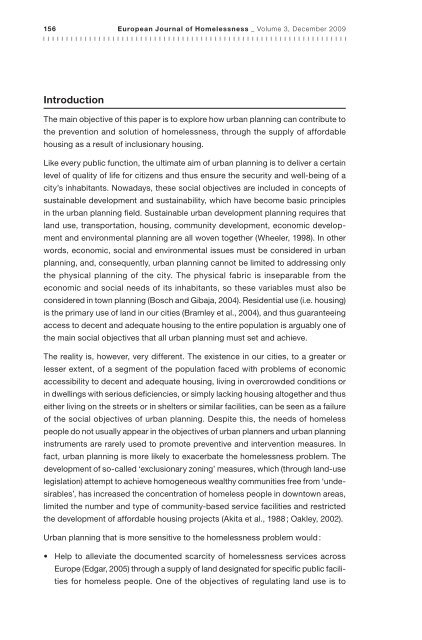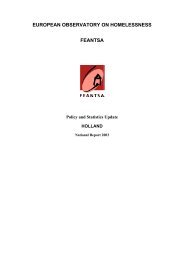Part A - Feantsa - Horus
Part A - Feantsa - Horus
Part A - Feantsa - Horus
You also want an ePaper? Increase the reach of your titles
YUMPU automatically turns print PDFs into web optimized ePapers that Google loves.
156 European Journal of Homelessness _ Volume 3, December 2009<br />
Introduction<br />
The main objective of this paper is to explore how urban planning can contribute to<br />
the prevention and solution of homelessness, through the supply of affordable<br />
housing as a result of inclusionary housing.<br />
Like every public function, the ultimate aim of urban planning is to deliver a certain<br />
level of quality of life for citizens and thus ensure the security and well-being of a<br />
city’s inhabitants. Nowadays, these social objectives are included in concepts of<br />
sustainable development and sustainability, which have become basic principles<br />
in the urban planning field. Sustainable urban development planning requires that<br />
land use, transportation, housing, community development, economic development<br />
and environmental planning are all woven together (Wheeler, 1998). In other<br />
words, economic, social and environmental issues must be considered in urban<br />
planning, and, consequently, urban planning cannot be limited to addressing only<br />
the physical planning of the city. The physical fabric is inseparable from the<br />
economic and social needs of its inhabitants, so these variables must also be<br />
considered in town planning (Bosch and Gibaja, 2004). Residential use (i.e. housing)<br />
is the primary use of land in our cities (Bramley et al., 2004), and thus guaranteeing<br />
access to decent and adequate housing to the entire population is arguably one of<br />
the main social objectives that all urban planning must set and achieve.<br />
The reality is, however, very different. The existence in our cities, to a greater or<br />
lesser extent, of a segment of the population faced with problems of economic<br />
accessibility to decent and adequate housing, living in overcrowded conditions or<br />
in dwellings with serious deficiencies, or simply lacking housing altogether and thus<br />
either living on the streets or in shelters or similar facilities, can be seen as a failure<br />
of the social objectives of urban planning. Despite this, the needs of homeless<br />
people do not usually appear in the objectives of urban planners and urban planning<br />
instruments are rarely used to promote preventive and intervention measures. In<br />
fact, urban planning is more likely to exacerbate the homelessness problem. The<br />
development of so-called ‘exclusionary zoning’ measures, which (through land-use<br />
legislation) attempt to achieve homogeneous wealthy communities free from ‘undesirables’,<br />
has increased the concentration of homeless people in downtown areas,<br />
limited the number and type of community-based service facilities and restricted<br />
the development of affordable housing projects (Akita et al., 1988 ; Oakley, 2002).<br />
Urban planning that is more sensitive to the homelessness problem would :<br />
• Help to alleviate the documented scarcity of homelessness services across<br />
Europe (Edgar, 2005) through a supply of land designated for specific public facilities<br />
for homeless people. One of the objectives of regulating land use is to




